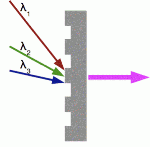By Dominic Siriani
Diode lasers found their place in the world many years ago. Early on, they let us listen to our CDs and later watch our DVDs. They are in our little laser mice and our room-sized supercomputers. They are largely responsible for the telecom boom, putting the internet at our fingertips, and so help me reach all who read this blog. Like the transistor that preceded it, the diode laser has established itself as a cornerstone of modern technology. So this begs the question: what’s next?
Well, the natural thing is to think bigger. I’m not saying make these lasers physically larger. One of them is smaller than a strand of hair from my head, and we like them that way. But the age-long question is how we can get even more out of these devices. How can we expand their sphere of influence to areas that require very high optical powers, while still maintaining their excellent efficiency and very small size?
Part of the answer has been known for a very long time, probably just about as long as the diode laser itself has existed: two lasers are better than one. By combining the emission from multiple diode lasers, you can still keep things pretty small and efficient but scale up to much higher powers.
Until quite recently in the history of diode lasers, this strategy really wasn’t so essential. Advances in materials growth and processing, development of new device structures, and a variety of other ingenious ideas led to the gradual improvement of diode laser power and efficiency over time. We might now be in the midst of a change. I wouldn’t go so far as to say that we’ve gotten to where, like the microprocessor, we’ve hit a physical limit for conventional scaling methods. However, advancements have become challenging enough that it’s very helpful to utilize more weapons in the scaling arsenal.
DSo, the idea is pretty straightforward: gang together a bunch of diode lasers to get to your desired higher power. In practice, there’s some subtlety to it. For example, do you want to have a high quality beam or can you tolerate low beam quality? Do you need emission at a single wavelength, multiple wavelengths, or does it not matter? Diode laser beam combining methods exist for all these scenarios.
Consider, hypothetically, that you need to dump a whole bunch of optical power into a small area. Well, then you probably need good beam quality. But if you can tolerate (or even use) multiple wavelengths,then you can use a
 Illustration of wavelength beam combining (like running a diffraction grating in reverse).
Illustration of wavelength beam combining (like running a diffraction grating in reverse).
technique known as wavelength beam combining, where, for example, lasers operating at regularly spaced frequencies are combined using a grating. Other techniques, like single-frequency phase-locking and incoherent beam combining, have their own sets of merits and application areas. These arrays really allow you to think of exciting niches for diode lasers: high-power solid-state laser pumping, laser welding, lidar, and the list goes on. And each one of these applications can require a different diode laser array type and beam combining technique. And, as one might imagine, there is not just one method to implement a particular technique. That’s great news: we’ve got all kinds of stuff to research!
This is a rather shallow overview of the importance, methods, applications, etc. of diode laser arrays and beam combining. And I really didn’t even touch on all the challenges! Luckily, there’s an entire symposium dedicated to high power diode laser arrays at the upcoming CLEO meeting. There you likely can learn more about the specific beam combining methods, where they’re useful, and what the state-of-the-art is. It’s an ever-evolving field, so it’s sure to be an exciting set of talks, pushing the envelope of what we can imagine diode lasers can do.
Disclaimer: Opinions, interpretations, conclusions, and recommendations are those of the author and are not necessarily endorsed by the United States Government and MIT Lincoln Laboratory.
Posted: 29 January 2013 by
Dominic Siriani
| with 0 comments